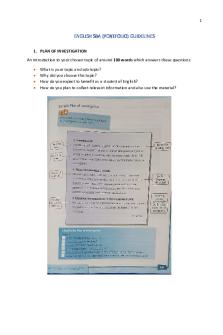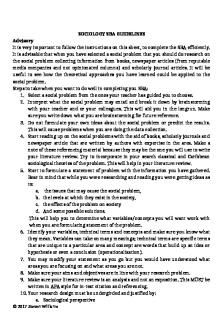CSEC Social Studies SBA Guidelines and rubric PDF

| Title | CSEC Social Studies SBA Guidelines and rubric |
|---|---|
| Author | Mandy Grimm |
| Course | Social psychology |
| Institution | Windsor University School of Medicine |
| Pages | 3 |
| File Size | 70 KB |
| File Type | |
| Total Downloads | 122 |
| Total Views | 842 |
Summary
CSEC SOCIAL STUDIES SBA GUIDELINESIMPORTANT NOTES:i. Do not use pronouns when writing the SBA. E. Instead of stating “I distributed...” state “the researcher distributed...”Task 1: Statement of Problem (2 marks) State the problem in the form of a question. The topic should have only one variable. E....
Description
CSEC SOCIAL STUDIES SBA GUIDELINES
IMPORTANT NOTES: i.
Do not use pronouns when writing the SBA. E.g. Instead of stating “I distributed…” state “the researcher distributed…”
Task 1: Statement of Problem (2 marks) 1. State the problem in the form of a question. The topic should have only one variable. E.g. What are the causes of young people to use illegal drugs in Sandy Bay? NOT What are the causes and effects of young people to use illegal drugs in Sandy Bay?
2. The Statement of Problem should not be able to be answered by “Yes” or “No”. E.g. “Is there a problem with gang violence?”. It should be “To what extent….”
3. Topic should be specific e.g. What, Who, Where, effects of, of fifth form students of the Basseterre High School, among the elderly in the McKnight community.
Task 2: Reason for Selecting the Area of Research (2 marks) This should have 2-3 strong sentences explaining the reason why the topic was selected. This task ought to be based on a situation that the researcher has experienced. E.g.. The researcher heard the residents in her area speak about Internet Fraud. It is her hope that her research can help people not to become victims in the future.
Task 3: Method of Investigation (2 marks) 1. Select an appropriate method of investigation. Such as: i. Questionnaire ii. Observation iii. Telephone Survey iv. Documentary Survey 2. Describe the Method of Investigation. Eg. The Questionnaire consists of 20 questions, 12 closed-ended, 5 open-ended and 3 “yes” and “no” responses. The Telephone Survey consists of 10 questions The researcher used an Observation Check-list to conduct his/her research. 3. Justification of the selected method- At least two properly explained reasons why you selected the method.
Task 4: Data Collection Instrument (4 marks) The QUESTIONNAIRE: 1. An Introductory Letter must be at the top of the questionnaire. It should also guarantee anonymity and confidentiality. Eg Dear Respondent, The researcher is conducting this survey as part of his/her CSEC Social Studies School-Based Assessment (SBA) . You will not be required to write your name so you can feel comfortable in answering all of the questions honestly. The information collected will be kept confidential. Thank you for your kind co-operation, (your name)
2. The first few questions should be biographical questions pertaining to: age, gender, form, occupation, religion, type of family etc. depending on your Statement of Problem. You should have 3-4 biographical questions. 3. When formulating your questions, ask the: who, when, why, how, where etc. in reference to the Statement of Problem. 4. Include questions that refer to the causes, effects and possible solutions in relation to the Statement of Problem. 5. The questionnaire should have 12-15 questions of three different types of responses: i. Closed-ended questions must have among the options, “Other” ii. “yes” and “no” responses (no more than 3 of these) iii. Open-ended questions (respondent has to write their response on the line provided).
Task 5: Procedure for Data Collection (2 marks) This is a brief description of how the sample was chosen/selected in the survey. 1. 2. 3. 4. 5. 6.
Indicate when and where the questionnaire was distributed. Indicate the size of the sample (20 respondents), the number of males and females and age groups. Describe the sampling method that was used e.g. Simple random sampling, Stratified random sampling Indicate if there were any problems e.g. Did not receive all completed questionnaires How much time was provided to complete the questionnaire? How many questionnaires were returned?
Task 6: Presentation of Data (6 marks) *Choose THREE questions that are most important to the research. These are what you will analyse, interpret then draw conclusions. 1. Select three key close-ended questions and illustrate the responses to each question using a bar graph, pie chart, pictograph or a table. You MUST have three different types of graphs/tables. 2. No yes/no questions or open-ended questions should be selected 3. No line graph, doughnut, cone graphs, cylinder graphs or any 3D graphs are to be used. 4. It is recommended that one question should focus on causes, one on effects and the third should focus on solutions to the problem....
Similar Free PDFs

Math SBA - math sba csec
- 6 Pages

499708865 English SBA Guidelines
- 7 Pages

SOCIOLOGY SBA GUIDELINES
- 7 Pages

IA Rubric-Math Studies IB
- 10 Pages

Social Studies - Let Reviewer
- 21 Pages

Diego Social Studies
- 4 Pages

Cultural studies social theory
- 23 Pages

CSEC English
- 61 Pages

Past Papers for Social Studies
- 25 Pages

2018 WI Social Studies Standards
- 42 Pages
Popular Institutions
- Tinajero National High School - Annex
- Politeknik Caltex Riau
- Yokohama City University
- SGT University
- University of Al-Qadisiyah
- Divine Word College of Vigan
- Techniek College Rotterdam
- Universidade de Santiago
- Universiti Teknologi MARA Cawangan Johor Kampus Pasir Gudang
- Poltekkes Kemenkes Yogyakarta
- Baguio City National High School
- Colegio san marcos
- preparatoria uno
- Centro de Bachillerato Tecnológico Industrial y de Servicios No. 107
- Dalian Maritime University
- Quang Trung Secondary School
- Colegio Tecnológico en Informática
- Corporación Regional de Educación Superior
- Grupo CEDVA
- Dar Al Uloom University
- Centro de Estudios Preuniversitarios de la Universidad Nacional de Ingeniería
- 上智大学
- Aakash International School, Nuna Majara
- San Felipe Neri Catholic School
- Kang Chiao International School - New Taipei City
- Misamis Occidental National High School
- Institución Educativa Escuela Normal Juan Ladrilleros
- Kolehiyo ng Pantukan
- Batanes State College
- Instituto Continental
- Sekolah Menengah Kejuruan Kesehatan Kaltara (Tarakan)
- Colegio de La Inmaculada Concepcion - Cebu





